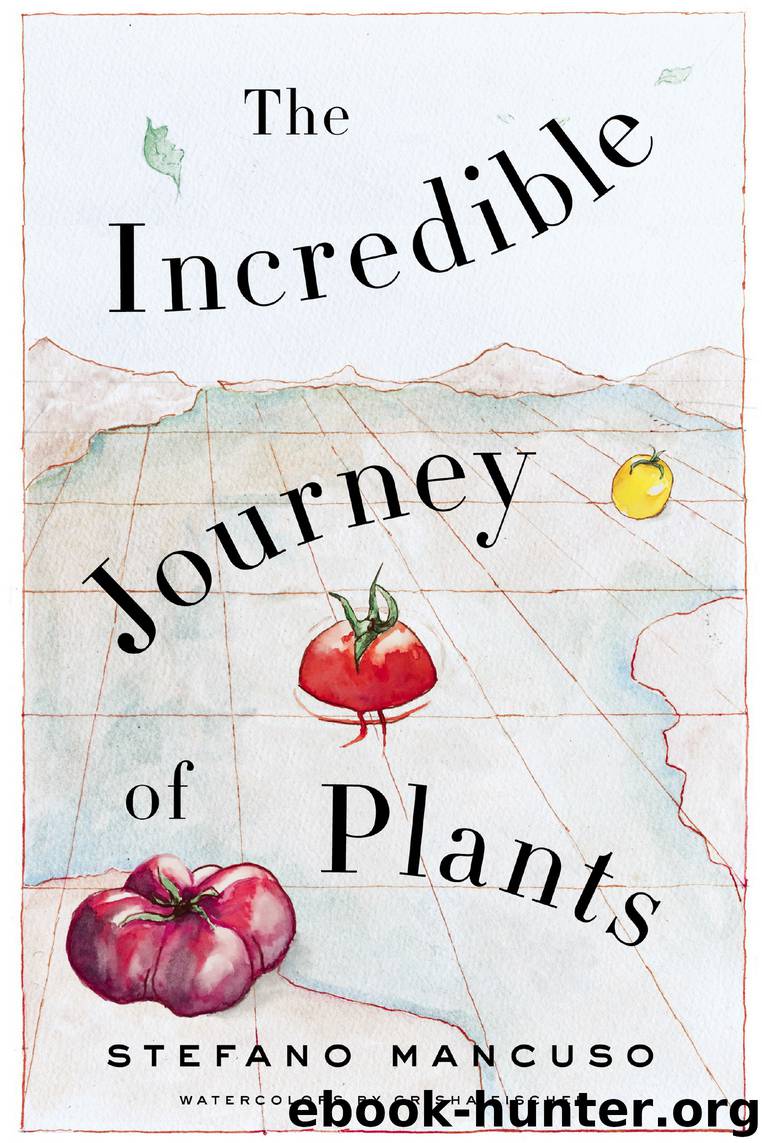The Incredible Journey of Plants by Stefano Mancuso

Author:Stefano Mancuso [Mancuso, Stefano]
Language: eng
Format: epub, azw3
Publisher: Other Press
Published: 2020-03-24T00:00:00+00:00
. 4 .
TIME TRAVELERS
type species Date Palm – domain Eukaryota – kingdom Plantae
division Magnoliophyta – class Liliopsida – sub-class Arecidae
order Arecales – family Arecaceae – subfamily Coryphoideae
tribe Phoeniceae – genus Phoenix – species Phoenix dactilifera
origin Northern Africa – dispersion Worldwide
first appearance in Europe Around the year 1000
Time travelers exist. At least in the direction that travels from the past toward the present. They are found all over the place. In fact, they are so numerous we don’t even notice them anymore. And you know who they are? You got it: plants. Some species, especially tree species, thanks to their longevity, which is incomparably longer than that of any animal, have traveled through time down to our day from very distant ages. Others, by protecting their embryos inside robust and unalterable seeds, allow their offspring to cross through time and space.
Champions of longevity are common in the plant world. Many species have the capacity to live more than a thousand years. Some, like Pinus longaeva—a name not chosen by chance—boast numerous members capable of living more than four thousand years. Some of them, the true champions, even reach the age of five thousand, or thereabouts. Methuselah, for example, a Pinus longaeva (bristlecone pine) that grows in California, has lived an estimated 4,850 years. For decades, this tree enjoyed the special status of the oldest plant in the world. It was the doyen of the Pinus longaeva and, therefore, of the entire vegetable kingdom. Its throne began to wobble when it was noticed that many exemplars of this species, despite not having been so fortunate as to have been given their own proper name—an indisputable symbol of privilege in the world of plants—had reached an age close to and, in some cases, superior to that of Methuselah himself.
But that debate has become less interesting since 2008, when Leif Kullman, a professor at Umeå University in Sweden, discovered a red fir tree (Picea abies—Norway spruce) that had reached the incredible age of 9,560. If we want to get picky, Old Tjikko—the name Kullman gave to this champion, in memory of his deceased dog—is a tree that has regenerated its trunk many times over the course of its life, rather than being a single tree of great age. Its roots, however, are still the originals, and the act of regenerating the trunk every five hundred to seven hundred years is precisely one of those mechanisms through which plants ensure themselves a longevity nonpareil.
Old Tjikko is indeed the oldest tree in the world. It was here seven thousand to ten thousand years ago when humans invented agriculture, freeing themselves from the necessity of using most of their time searching for food to survive, and it has continued to exist as we have been developing our entire civilization.
Then, of course, there are the great clonal organisms, such as Pando, a 106-acre trembling poplar forest in Utah, comprised of a single genetic individual, which has been propagating itself, unchanged, for more than eighty thousand years. A practically immortal being that has been living since an era so ancient as to be almost incomprehensible to us.
Download
The Incredible Journey of Plants by Stefano Mancuso.azw3
This site does not store any files on its server. We only index and link to content provided by other sites. Please contact the content providers to delete copyright contents if any and email us, we'll remove relevant links or contents immediately.
The Lonely City by Olivia Laing(4772)
Animal Frequency by Melissa Alvarez(4430)
All Creatures Great and Small by James Herriot(4277)
Walking by Henry David Thoreau(3926)
Exit West by Mohsin Hamid(3796)
Origin Story: A Big History of Everything by David Christian(3666)
COSMOS by Carl Sagan(3592)
How to Read Water: Clues and Patterns from Puddles to the Sea (Natural Navigation) by Tristan Gooley(3434)
Hedgerow by John Wright(3319)
How to Read Nature by Tristan Gooley(3294)
The Inner Life of Animals by Peter Wohlleben(3286)
How to Do Nothing by Jenny Odell(3265)
Project Animal Farm: An Accidental Journey into the Secret World of Farming and the Truth About Our Food by Sonia Faruqi(3192)
Origin Story by David Christian(3170)
Water by Ian Miller(3157)
A Forest Journey by John Perlin(3044)
The Plant Messiah by Carlos Magdalena(2900)
A Wilder Time by William E. Glassley(2837)
Forests: A Very Short Introduction by Jaboury Ghazoul(2815)
